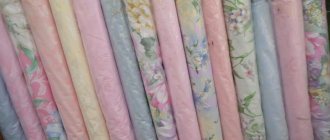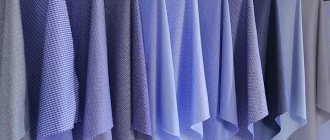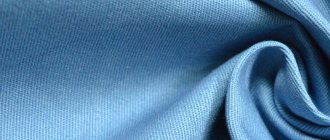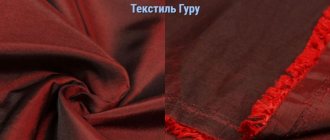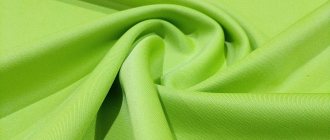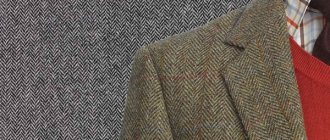Origin story
Since ancient times, humanity has been looking for options for creating impregnations that provide moisture-proof properties and high abrasion resistance. Such examples were floor coverings that preceded the invention of linoleum, and the appearance of latex-impregnated clothing and shoes among Indians. To give strength to sails, the Vikings used the method of oiling the fibers.
The tsarist government of the Russian Empire was concerned about the high costs of supplying the army with genuine leather products. The power was faced with the task of finding a replacement for expensive resources by developing materials that demonstrate moisture resistance and strength.
The tarpaulin owes its appearance to the Russian military inventor Mikhail Mikhailovich Pomortsev. In 1903 he began a series of experiments with rubber substitutes. A year later, the scientist received a waterproof tarpaulin, which was used for sewing gun covers and fodder covers.
M. M. Pomortsev, continuing his experiments, created an emulsion with which tarpaulin could provide hygiene on a par with natural leather. It contains egg yolk, paraffin and rosin. Multilayer fabric impregnated with such a mixture had the ability to “breathe” and did not allow moisture to pass through.
During the First World War, the inventor donated the idea of creating a leather substitute, called tarpaulin, for the manufacture of army shoes to the Military Industrial Committee. The government authority accepted the idea and ordered the production of a large batch of boots and shoes.
The decision was opposed by industrialists and manufacturers who did not want to incur losses due to the low cost of the new material. And the “tarpaulin boot” was forgotten for a long time.
The rebirth of the material occurred thanks to Russian scientists in the pre-war years. In 1934, engineers Plotnikov and Khomutov designed the equipment, and the Soviet Union received the first batch of tarpaulin. Instead of Pomortsev's composition, synthetic rubber was used as impregnation, which significantly reduced wear resistance.
In August 1941, in conditions of a catastrophic shortage of military uniforms, Ivan Plotnikov, appointed chief engineer of Kozhimit, was tasked with improving the material, finding a composition that would soften the fabric and make it more elastic and durable.
For the successful completion of a strategic task in April 1942, the engineer was awarded the Stalin Prize along with the developers of new types of weapons. Shoes made of tarpaulin were light, did not get wet, and retained heat.
Photos and video materials from the Second World War indicate that a Russian soldier walked from Moscow to Berlin in tarpaulin boots. There is a monument in the military village of Zvezdny, Perm Territory. On its pedestal there are kirzachs weighing 40 kg, made of bronze, which became one of the symbols of Victory.
History of tarpaulin boots
What is shoe tarpaulin? The soldiers of the Russian army in the First World War were the only ones who wore leather shoes. This can be called the merit of Pomortsev and Plotnikov. The first discoveries were made by Mikhail Pomortsev. He created this material, but it was not profitable to use. The factories did not approve of the material, and after his death they forgot about it.
You might be interested in what fabric is used for bathroom curtains
Tarpaulin boots
By the middle of the 20th century, there was a noticeable lack of money to maintain the army. Plotnikov was instructed to improve the material in a minimum amount of time. His research and experiments took about a year, his discovery helped the army. The first test for tarpaulin boots was the Soviet-Finnish War. The experiment ended unsuccessfully; the boots were cracked due to the cold.
Product made from tarpaulin
Important! By the end of the war, about 10 million people wore these boots. The boots traveled with them all the way to Berlin. Kirzachi is one of the symbols of victory.
For more than a century, tarpaulin boots have served the Russian army. Thanks to them, the feet did not get wet, that is, there were fewer illnesses and deaths at the front.
Descriptions and properties
85% of all material is produced in Russia. Kirza is used for sewing shoes. In some models, the toe and heel are made of yuft leather. The use of a leather substitute made it possible to reduce the cost of production. What tarpaulin boots are made of can be answered unequivocally: from breathable waterproof fabric.
Kirza is an artificial material created from a base of plant origin with a special impregnation that ensures heat retention and water resistance. The fabric feels dense and rough to the touch. Double-faced canvases - with or without leather-like embossing on one side. Tarpaulin shoes and boots are difficult to distinguish from genuine leather products from photographs.
The inner layer absorbs moisture, so in shoes made of this material your feet do not freeze in any weather. A tarpaulin boot can protect against hypothermia in frosts down to minus 40 degrees.
How to wear it correctly
Military tarpaulin boots can be worn with socks or foot wraps. But those people who have tried to use both products note that the first ones simply roll off in their boots. During long marches and military operations, it is not always possible to adjust your socks. As a result, the legs can be rubbed until they bleed, which means the fighter is incapacitated.
The need to use foot wraps in the army is due to the fact that it is impossible to take into account the size of the feet of all military personnel. And the use of socks, as mentioned earlier, is impractical. A footcloth is a universal tool; to wrap your legs, it just needs to have sufficient dimensions.
How to wind a footcloth:
- To make it you will need a piece of fabric approximately 35 x 90 cm.
- The product is wound tightly, from the toe of the foot and towards the outer surface, otherwise it will get confused when walking.
- If you need to wrap a footcloth around your right leg, place your foot on the fabric closer to the right edge, 20 cm from it.
- With your right hand, take the short edge of the material and wrap the foot on top.
- The corner of the footcloth is tucked under the leg and secured with the long end.
- Turning around, the long edge of the fabric is wrapped around the back of the foot, sole and heel. The same end is wrapped around the shin, heading up the leg.
- The fabric then runs along the bottom of the shin, covering the front edge, and is secured with a fold on the inside of the foot. A similar procedure is done with the left leg, everything is done in a mirror manner.
To wind a footcloth, you do not need to have any special skills, 1-2 training sessions are enough. The versatility of the product lies in the fact that a piece of any material can be used to make it. In the summer, it is better to use cotton fabric for these purposes; in winter, foot wraps made of woolen materials, flannel and flannel are recommended.
Tarpaulin boots are worn with foot wraps
Stages of proper winding of foot wraps
How and from what they are made
The production of tarpaulin is classified as a technology using a high-molecular compound. The leatherette is based on multi-layer cotton fabric made from combed or carded yarn (medium and long fibers) with a density of 250 - 370 g/m2. m.
A rubber layer is applied to the canvas at a certain temperature. After cooling, the material is impregnated with a special composition.
Types of tarpaulin depend on the components used in fabric processing:
- acrinite is a mixture of rubber and latex (designated “A”). Polymethyl methacrylate is used as an impregnation;
- benzine-water impregnation and rubber dispersion (symbol “B”);
- latex impregnation, called spur-saddle.
The technological process takes place in several stages:
- Warp weaving;
- Impregnation with rubber compound.
- Heat treatment.
- Seal.
- Production of embossing on the front surface.
- Formation of rolls.
Characteristics
A description of the properties will help you understand the question: tarpaulin, what kind of material it is. The table will introduce the technical characteristics:
| Properties | Indicators |
| Purpose of the material | Shoe, technical fabric |
| Base composition | Natural plant origin |
| Method of weaving fibers | Plain (plain) weave |
| Density, g/sq. m. | 250 – 370 |
| Hygroscopicity,% | ≤ 1 |
| Water resistance | High |
| Main component of the synthetic layer | Rubber |
| Moisture absorption rate | Least |
| Air exchange | Short |
| Vapor permeability | Low |
| Electrification | Minor |
| Standard width of the web in a roll, cm. | 145 |
| Dyeing method | Plain dyed fabric |
| Parties | Double-faced with or without embossing, imitation leather on the front side |
| Main manufacturer | Russia |
| Standardization | GOST 2291 – 77 |
| Price | Available, from 250 rub. per meter |
Advantages and disadvantages
The main advantage of using tarpaulin in the production of military footwear is wear resistance and minimal cost. Therefore, the main purpose of the material is the manufacture of tarpaulin boots and boots.
In addition to these qualities, it is worth noting the properties that are advantages:
- maximum water resistance;
- abrasion and tear resistance;
- resistance to mechanical damage;
- the ability to accumulate static electricity is minimal.
When choosing products made from tarpaulin, it is worth considering the disadvantages:
- does not tolerate maximum low and high temperatures (the surface may crack);
- shrinks when exposed to heat;
- increased rigidity;
- meager color palette (black and dark gray, less often bleached and dyed samples).
Kirzach vs ankle boots. Part 2
The question of the confrontation between tarpaulin boots and ankle boots becomes even more interesting if we remember that the Red Army was well acquainted with both lace-up boots and boots, and not at all in individual comparisons, but in mass wear. Ultimately, the choice was made in favor of the tarpaulin boot.
Boots and boots in one order
From boot to boot...
The soldier's footwear in the Russian army during the First World War was the yuft boot. During the entire war, about 63 million pairs of boots were prepared, and 460 thousand poods (7.3 thousand tons) of sole leather were spent on repairing shoes. This was not enough, and together with the massive conscription, with the irrational and predatory attitude towards shoes among soldiers, difficulties in organizing production and other problems, boots in Russia ran out of boots in warehouses and on the market by the end of 1914, and in 1915 the troops received 65% the boots they need. In 1916, reinforcements from reserve battalions began to be sent to the front in bast shoes. In addition to bast bast shoes, the troops, following the Bulgarian example, made leather bast shoes “opanka”. The raw material for their production was leather removed from livestock slaughtered for meat, and the 7th Army in Galicia, having suffered from the lack of boots, organized its own tannery and shoe factory.
Opanki from the Livno Museum, Bosnia and Herzegovina.
Russia was forced to resort to purchasing shoes abroad; the first such purchases began in 1915. From January 1916 to July 1917, 5.8 million pairs were ordered abroad. Since the Entente allies did not sew boots, the Russian soldier had to become familiar with boots with lacing and tapes. After the revolution, boots with tapes became the main infantry footwear in the Red Army, apparently due to the fact that the Bolsheviks got quite large stocks of these shoes. However, subsequently boots with windings became the main footwear of the Red Army for the entire interwar period; for the first time, the mass replacement of boots with boots began only in 1940. The soldier's cowhide boot in its design was almost no different from the American Trench Boot, from which it most likely originated.
Now this is a very interesting moment. For the first 20 years of its existence, the Red Army used “correct” boots instead of “wrong” boots, but still abandoned them. So there were very good reasons for this.
The first and most obvious reason was that our climate, generally colder than that of Europe and America, requires warmer footwear. The average annual January temperature in Belgium is +1 near the sea and -1 in the Ardennes, in the UK about 0, in the USA +1 in Philadelphia and about 0 in Boston, and the proximity of the ocean, heated by the Gulf Stream, makes the climate mild, with slight fluctuations in daily temperatures. So wearing boots in these countries is not cold even in winter. In addition, colonial powers such as Great Britain and France fought wars almost exclusively in hot countries, either arid and desert or in the humid tropics. The Russian climate is significantly more severe, with an average long-term January temperature of -7.5, and cold weather sets in from November to March, that is, for six months. Also, the sharply continental climate gave daily temperature fluctuations of 5-7 degrees, not counting severe frosts. Meanwhile, the troops were forced to wear boots with tapes all year. Before the war, three pairs of cowhide boots were sold for two years, that is, with a wear period of 8 months. A boot with a thick footcloth looked clearly preferable for the domestic climate.
The second reason for abandoning boots was technological - they invented the famous tarpaulin. The Red Army held on to boots for quite a long time, as shoes that required less leather to make. Not only did the boot require approximately 40% less leather than a yuft boot, but the leather could also be of lower quality and rougher. The high tops of yuft boots required high-quality leather, well-dressed and free of any defects. For the USSR of that time, which after a long imperialist and civil war had lost about a third of its previous livestock, saving leather was significant.
At the very beginning of the 1930s, Stalin introduced a policy of radical restructuring of agriculture. It included not only dispossession and collectivization, but also the creation of a huge network of gigantic state farms, which were supposed to provide the country with both grain and meat. The state farm trust “Skotovod” was supposed to become an association of “meat factories”: state farms for breeding and fattening livestock. The idea did not work out (we will not consider the reasons here; for shoemaking, only the fact itself is interesting), living state farms actually produced nothing. Moreover, as a result of collectivization and the state farm epic, there was a large loss of livestock. If in 1928 there were 60 million heads of cattle (cattle provided the vast majority of the leather), then in 1933 there were 33.5 million heads left. Almost halved. Leather procurement also decreased proportionally, which put the army’s supply of leather products (which included not only boots, but also belts, pouches, saddles, collars, harnesses) in a threatening situation.
It was at this moment that the tarpaulin appeared. An interesting document has been preserved - a transcript of a meeting of the Military Council under the People's Commissar of Defense of the USSR, held in December 1935, at which the head of the Red Army Supply Department, Corintendent D.I. Kosich represented the People's Commissar of Defense of the USSR, Marshal of the Soviet Union K.E. Voroshilov this same tarpaulin boot: “I must report to you, Comrade People’s Commissar, that the troops unanimously refuse boots with tapes. Therefore, on your orders, I have already given these boots, the tops of which are made exclusively of cotton fabric, to be tested by the troops (demonstrates a sample of boots). A month's use of these boots shows that they give the impression of leather boots in appearance and give good results in terms of wear. These boots consist of five layers of cotton fabric, impregnated with a special compound that was invented in the laboratory. They look good and wear very well.”
So, from this speech by Corintendent Kosich it is clear that the issue of introducing tarpaulin boots was decided at the very top, at least by the decision of Voroshilov, which, most likely, was discussed in the Politburo of the Central Committee of the All-Union Communist Party of Bolsheviks, and already in the fall of 1935 the first batch of tarpaulin boots was made for tests. By the way, Kosich calls the material “kerza”, which indicates that the origin of the name is not from the “Kirov Plant”, but from the name of a coarse technical fabric. In general, common stories about the appearance of the tarpaulin boot contain a fair amount of mythology, which is not surprising. Corintendent Kosich was executed by firing squad in November 1937.
What prevented the introduction of a new boot? Its mass introduction occurred already during the war, but in December 1940, the head of the Main Quartermaster Directorate of the Red Army, Lieutenant General of the Quartermaster Service A.V. Khrulev proposed replacing three pairs of boots for the army for two years with three pairs of tarpaulin boots, and for the rear units, departments and institutions, the replacement was supposed to be one pair of tarpaulin boots and two pairs of boots with windings.
This decision was carried out with a delay for the simple reason that the technology for manufacturing the material itself had not been worked out and it took some time to solve the technical problems. Therefore, during the war, the Red Army put on boots gradually.
The tarpaulin boot is a petroleum product
What is tarpaulin? Essentially, it is a rubberized fabric impregnated with a special mixture consisting of synthetic rubber, carbon black, heavy bitumen, gasoline, sulfur, zinc oxide (the last two for vulcanizing the rubber). The impregnated fabric vulcanized like any other rubber. Coarse cotton fabric, folded in 3-5 layers, was impregnated with this composition, dyed, then processed on calenders, vulcanized and re-dyed. At the last stage, a casein coating was applied to the surface. The finished tarpaulin was rolled into rolls.
Finished tarpaulin in the warehouse of Zavod-Kirza LLC in Lipetsk
As with any rubber product, the properties and quality of the product depend decisively on the selection of the rubber mixture formulation and the selection of its processing mode. This is not at all as simple as it might seem at first glance, and developing a recipe can take many years.
This was a decision of economic significance. A tarpaulin boot consists of only 15% leather (the bottom of the boot and the sole, which are usually made from rough types of leather), and the rest is tarpaulin. Leather consumption has been further reduced even compared to boots. It was also important that now most of the boots were made from raw materials obtained in other industries and little dependent on the development of livestock farming. The USSR was one of the first to master the industrial production of synthetic rubber; in 1933, three factories operated: Yaroslavl, Voronezh and Efremov, producing butadiene rubber according to the method of S.V. Lebedeva. Ethyl alcohol was needed as an intermediate product, which was obtained from grain, potatoes or hydrolyzed wood, but already in 1934, a technology for producing alcohol from oil gases was developed in Baku; After the war, the production of synthetic rubber from oil or natural gas became completely dominant. Subsequently, other types of tarpaulin appeared, such as villin leather, made from polyester fabric and polyvinyl chloride emulsion. So the post-war tarpaulin boot was largely a petroleum product.
By the way, this was a significant military-economic conquest, allowing, in principle, to equip an army of almost any size. The production of boots ceased to depend on the number of livestock and the procurement of leather, because, if necessary, boots could be made entirely from tarpaulin with rubber soles. It’s still impossible to fight without synthetic rubber, but by using a relatively small part of it to produce boots, you can put shoes on the army and all possible mobilization contingents.
... and back from boot to tarpaulin boot
In total, during the war years, the Red Army received 63.79 million pairs of new shoes, including 12.5 million pairs of shoes received under Lend-Lease (these were, of course, American boots - Combat Service Boot). The average annual strength of the army was 8-9 million people, and by the end of the war it rose to 11 million people. In principle, this amount of shoes was enough to provide the army (during 46 months of the war, six issues of shoes were required for a wear period of 8 months; 63 million pairs were enough to provide an army of about 10.5 million people with shoes for the entire duration of the war) . Unlike World War I, acute shoe shortages no longer plagued the army. Firstly, Comrade Stalin carried out educational work and the people now knew what the theft of socialist property was and how it ended. Therefore, the mass sale of boots by soldiers, as before, became impossible. Secondly, the repair of shoes in the troops was organized, and a total of 61.4 million pairs of shoes were passed through it. That is, almost every pair of boots or boots was repaired at least once. The repairs compensated for the increased wear and tear on the shoes.
[center]
Repairing boots in an army shoe workshop
Let's pay attention to how many shoes are required for a big war. First World War - 65 million pairs of boots (excluding bast shoes, etc. improvisation), Second World War - 63 million pairs. In the USA, the scale of production of military footwear has exceeded these figures many times over. In the last peaceful year, 1941 (let me remind you that the war for the United States began in December 1941), 15 million pairs of boots were manufactured, and already in 1942 - 41 million pairs. In total, 190.2 million pairs of boots were produced during the war. Of these, about 120 million pairs were worn out by the American army itself, the rest either went to the allies or remained in warehouses and was gradually used up.
Therefore, in matters of choosing footwear for the army, it is extremely insufficient to take only the convenience of a particular type of footwear; one must also take into account the possibility of organizing mass production if necessary. In peacetime, the needs are relatively small: an army of millions wears out 1.5 to 2 million pairs per year. But with the beginning of mass mobilization, when armies of 5-6 million or more are assembled, the need for standard army shoes increases sharply.
The final choice in favor of the kirzach was made, obviously, precisely for military-economic reasons, as the simplest and most technologically advanced model to manufacture, using mainly synthetic materials. In addition, operating experience leaned in favor of the kirzach. Let us note that the quartermaster department of the Red Army, of course, analyzed and generalized the experience of wearing boots and boots during the war. It had the opportunity to compare boots and boots. The choice made in favor of boots shows that boots did not have any significant advantages over boots. And this is not someone’s subjective opinion, but the summarized experience of the army, through which more than 34 million people passed.
Now the choice has been made again in favor of the boot, but there is some premonition that the confrontation between the kirzach and the high boots is far from over, and in a future war this issue may again come to light. The next part will be devoted to this.
Application of material
In the Soviet Union, in the post-war years, tarpaulin was used in the production of army uniforms:
- as a material for the tops of soldiers' boots;
- Sewing motorcycle leggings;
- Production of officer tablets;
- Damaged gun cases;
- Holsters for pistols;
- Bandoliers.
Modern industry uses tarpaulin to make the following things:
- Army combat boots and boots;
- Work and sports shoes;
- Gun cases;
- Inserts in work clothes, robes;
- Ammo pouches;
- Briefcases, backpacks, bags;
- Punching bags and gloves;
- Packaging materials;
- Drive belts.
Analogs
Two types of fabric from which shoes are made are considered analogues of tarpaulin:
- Yuft is a natural material of animal origin. Demonstrates optimal hygiene. Unlike tarpaulin, it is expensive and is supplied to shoe production in limited quantities.
- Leather substitutes are affordable materials. Compared to tarpaulin fabric, they are inferior in terms of wear resistance. They do not allow air to pass through, which makes the materials unhygienic and unable to retain heat in cold weather.
Care instructions
Caring for products made from the material is easy. It is important to follow the rules to extend the service life. You can clean things made of tarpaulin with a damp cloth or a medium-hard brush dipped in a soap solution. It is acceptable to use creams and protection products for shoes.
Drying is carried out at 30 - 40 ° C in rooms with good air circulation. It is not recommended to store products in places exposed to direct sunlight. Sudden temperature changes should be avoided.
Dry cleaning for tarpaulin shoes and accessories is impractical.
How to care for something made of tarpaulin
Actually, it's not that difficult. One of the differences between tarpaulin is that this material is easy to care for. This question is often asked by people who were not in the army. Everyone there knows it. Kirza was originally a material for shoes. What needs to be done to care for tarpaulin, no matter boots, a bag or something else. The main thing is that they are made of tarpaulin and they need care.
Material care
- Things need to be lubricated with fats. For example, goose, pork and others. This will improve the waterproofness of the item. Oil cannot be used (on the material itself, we are talking about oil from the diet). Grease should be applied to washed and dried items. If you notice excess fat after a couple of days, remove it.
- Regular shoe care products will also work. For example, shoe polish, polish. Please note that this care tip is for boots only.
- As for oils, not everything is so exclusive; they can be used to lubricate seams. Castor oil is suitable, in addition to it, you can take any other fat.
- Wipe with various creams several times a week. But only if the item is used almost daily. In other cases it is not required.
- If water gets on the material, it must be dried. Of course, if possible. There was not always war during the war.
You might be interested in Description of textiles, as well as textile products
With the right approach to caring for the item, it will last for many years. It is quite easy to care for the tarpaulin. An amazing material that has many advantages, is also unique in some properties, and is easy to care for. Creams can be used based on organic solvents.
If the material is handled incorrectly, it will not last long. Although the quality is very high. Without care, the material will begin to break, tear, harden and fall apart. Therefore, it is worth paying attention to caring for the tarpaulin.
Product made of material
